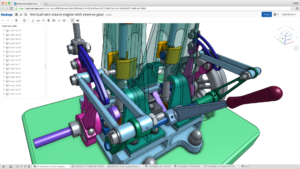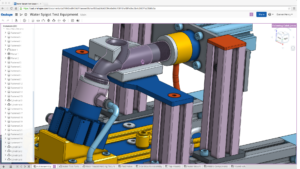Onshape, the latest entrant to the elite club of professional CAD products, stands out as a cloud-based tool designed to foster collaboration. Will the CAD community accept workflows based in the cloud? This team of veterans from SolidWorks and other CAD and high tech pioneers thinks so.
In CAD land, there are people who can command investment dollars with the merest twitch of an eyebrow. They have the Midas Touch, they’re the Massachusetts brain trust and they’re at it again, toiling away in semi-secret at the former Belmont Technologies and now renamed Onshape. Founded in 2012 by former SolidWorks founders and a bunch of new friends, Onshape is planning to revolutionize the CAD industry, again. They’re going public with their new CAD product on March 9, 2015. Onshape is a cloud-based CAD system, which, as you can imagine has inspired doubtful head shaking or enthusiastic fist pumps.

The people who founded Onshape in 2012 include Jon Hirschtick and Scott Harris who were on the founding team of SolidWorks along with John McEleney, Dave Corcoran, Michael Lauer, and Ilya Mirman, also longtime SolidWorks execs. Former SolidWorks CEO John McEleney, went off to run CloudSwitch for a while, and he brought CloudSwitch founding engineer John Rousseau to the Onshape leadership team. Almost as soon as there were rumblings about a new CAD dream team in the Boston area, talent started flocking to the company. The expertise in CAD and cloud-based software runs deep, but there are also a lot of bright young things from the best engineering schools in the world. OnShape has 60 employees making do with $64 million in venture capital (from Commonwealth Capital Ventures, North Bridge Venture Partners, and NEA)
The company has been talking to the CAD press and showing demos under NDA. I talked with Joe Dunne, another SolidWorks veteran, who explained a little bit about the philosophy behind the new company and let me play around with the product. It’s important to note that I was easily able to play with this brand new beta software seconds after Dunne and I connected on the phone. There are no downloads, no installs, just a polite invite, and I’m in business. The other aspect is that, I didn’t have much trouble figuring out how to build a basic model right away.
What sets Onshape apart from the desktop CAD system used today is the ease with which users can share, comment, collaborate on the drawings and models they have created. With desktop CAD, every 3D part and 2D drawing is stored in a separate file. Assemblies are yet another class of files that store information about how parts relate to one another. To share these files, designers must somehow transmit them to clients, customers, or suppliers. To view them, the recipients must have the same CAD software or some other sort of software that lets them see the models and drawings. Sometimes these viewers require files be translated to yet another file format, such as SolidWorks eDrawings or Autodesk’s DWF. Product-data management (PDM) systems are supposed to manage these complex translations and exchanges, but in practice, designers often send files by e-mail, FTP, or Dropbox. Once such files are sent, there is no way to call them back or to know if they have been superseded.
Because Onshape stores models in a file-free database in the cloud, everyone who interacts with them is working with the same model. There are no file translations. Permissions to view, measure, or edit files can be withdrawn from people who no longer have a need for them. Appropriate versions are readily apparent. And in the future Onshape will enable large customers to know with certainty who has their engineering information and what they are doing with it.
“The technology, the market, and the business model is ripe for change,” says Dunne. That’s true, and we’ve been hearing the same thing from just about every quarter of the CAD community. There have been several CAD products developed for the cloud including TinkerCAD and Lagoa CAD, which were acquired by Autodesk, and of course Autodesk has also offered its home-grown Fusion 360 CAD system. There are many advantages to cloud based tools, but for developers a big advantage comes from not having to support multiple hardware platforms and ship multiple versions of products.
The Onshape team believes the most important challenge is not making 3D CAD models and drawings. They think the problem is accessibility, administrative costs, time lost finding the right file, or being sure everyone is on the same version of software. All this overhead is a distraction from the core task of getting products to customers.

That said, however, the Onshape team also welcomed the chance to build a new CAD tool. They started with the basics using the Parasolid modeling engine, which forms the underpinning of SolidWorks, Siemens NX, Solid Edge and other tools, and the D-Cubed software libraries for geometric constraint solving, parametric sketching, part and assembly design, motion simulation, collision detection, clearance measurement and hidden line visualization. Thus, Onshape combines direct modeling approaches with constraints-based sketching. “People want both,” says Dunne.
What’s most noticeable about Onshape is how inviting it is. It has a very modern, very clean, no-fuss interface. The team is not just taking their cue from generations of CAD design, they’re also building on the lessons learned from cloud based tools like Google Docs, or the programmers darlings GitHub, Salesforce, etc.
Onshape allows people to work together in an organized fashion. Like GitHub, Onshape allows engineers to veer off into a different branch where someone might work on their own aspect of a design. Branches stay with the base design, they can be shared, or not, depending on what the workers are trying to do. When a unified approach is agreed upon, branches can be merged together. When you’re working within Onshape you can easily see what’s going on with the design from a tabbed interface.
Onshape offers the ability to use and share existing CAD files. CAD files can be uploaded and the owner can control the level of access, grant, and revoke permissions. So, Onshape can be used as a resource to store, manage, and version control CAD files and the file can be translated into Onshape’s native format to be viewed and edited online on any platform. Translated files can be edited using Onshape’s direct editing tools. This gives companies a gentle on-ramp to gradually move their workflow to Onshape.
Unlike those cloud-based CAD tool that have gone before like TinkerCAD and LagoaCAD, the Onshape team has built a professional tool with advanced capabilities – we’re going for industrial strength, says Dunne. Onshape uses two-step verification to allow people to sign on for security. On the flipside though, Onshape just works. It doesn’t require a fast Internet connection, it’s just sending bits back and forth and, says Dunne, it’s built to scale. The thing is architected for millions of users, he said.
It’s architected for a new generation. Onshape’s cloud-based architecture scales to access as many cores as it needs. The Onshape engineers don’t think it makes sense for resource intensive programs like CAD to rely on the limited resources of a desktop machine when there are infinite resources in the cloud. Much of today’s CAD software relies on the CPU and most of it doesn’t take advantage of multiple cores. Onshape, and the other 3D programs in the cloud, are built on the WebGL API, which means they can scale up to all the cores that are available in the cloud – as long as you’re working on a browser that supports WebGL and modern browsers now support WebGL except the current version of Microsoft’s Internet Explorer (Microsoft has signed on to support WebGL in future versions).
As I played with the program, Dunne told me, this is as slow as its going to get. The company is planning to scale up to make more resources available around the world—as many resources as customers need. There’s no saving, you never crash. This thing is distributed all over the place, says Dunne.
Nothing resides on the host computer, it’s all in the cloud. For the Onshape folks, this is a plus, but you can bet there’ll be some noise coming from people who are uncomfortable about their data living up in the cloud, vulnerable to the zombie apocalypse or even Internet outages. Onshape is banking on the future. As it is now, most people in the U.S., Europe, much of Asia have access to good Internet connections and the world’s connectedness will improve. There is a generational divide between people who are comfortable with taking advantage of cloud-based resources and people who want to wrap their arms around their work and keep it safe, and close. I don’t think this is actually an age thing, though age definitely plays a strong role. It’s more a matter of experience. The availability of new resources, free training, less expensive or even free tools is making more people willing to try out new approaches.
Onshape is playing the long game and they figure they have time. Onshape does not envision the CAD world throwing down the tools they’ve been using for the last 20 years just because this bunch introduces an attractive new product, but they believe people will start making comparisons between Onshape and their older tools and see the advantages to the Onshape approach.
Onshape has basic PDM capabilities because work is organized into projects with all associated documents. Related models, snap shots, etc. can be maintained and shared among team members. The share button is the bible for us, says Dunne who also says Onshape will be free because we need that part to work. People have to be able to freely share any part of their work, without really thinking about it.
So, Onshape is free, but, says the company, you have to pay for privacy. Customers will pay a monthly subscription fee and they can start and stop their subscriptions as they need the product.
Of course in a world of heterogeneous, file-based CAD, CAM, and 3D printing, it’s necessary to get files out so that other software can used them. Consequently, Onshape exports files in a number of common formats. But Onshape hopes to entice application-developers to write their own analytical and manufacturing applications for the cloud that can work with Onshape data. Once files are exported, the benefits of the cloud-based approach are lost.
What do we think?
Autodesk CEO Carl Bass has said that he thinks it’s ironic that people designing the products of the future should be doing it with software invented 20 years ago. There is a groundswell building that is going to change the process of design-build-manufacture just like the era of 3D modeling modernized the process of manufacture and architecture 20 years ago. It’s not going to be about the tools; it’s going to be about what the tools can do for the people who are using them. Do they facilitate the process or slow it down? That’s going to be all that matters in this next generation.
Additional reporting and substantial insight has been contributed to this article by L. Stephen Wolfe of Jon Peddie Research and CAD/CAM Publishing.





